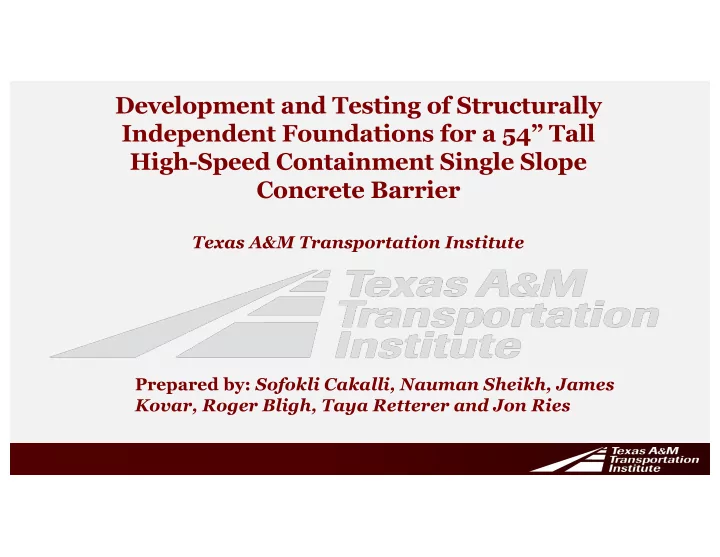

Development and Testing of Structurally Independent Foundations for a 54” Tall High-Speed Containment Single Slope Concrete Barrier Texas A&M Transportation Institute Prepared by: Sofokli Cakalli, Nauman Sheikh, James Kovar, Roger Bligh, Taya Retterer and Jon Ries
Presentation Outline 1. PROBLEM STATEMENT 2. DESIGN DETAILS 3. FINITE ELEMENT MODELING AND MASH 5-12 SIMULATIONS 4. MASH 5-12 CRASH TEST 5. RESULTS Cakalli, Sheikh, Kovar, Bligh, Retterer and Ries
1.Problem Statement TxDOT Bridge Design Manual • Section 2.2 requires that “bridge columns adjacent to roadways that exceed specific annual traffic frequency to be designed for impacts from heavy trucks, or be shielded with a barrier.” The barrier must be 54” tall and • Dallas, Texas 2007 - TxDOT mounted on a structurally independent foundation (SIF). The 54’’ tall Single Slope Concrete • Barrier (SSCB) must pass Manual Assessment of Safety Hardware (MASH) Test Level 5 and be installed for piers located 10-ft from the edge of roadway. Tyler, Texas 2008 - TxDOT Cakalli, Sheikh, Kovar, Bligh, Retterer and Ries
2.Design Details MASH TL-5 Single Slope Concrete Barrier with 6-ft Drilled Shaft Foundation Cakalli, Sheikh, Kovar, Bligh, Retterer and Ries
3. Finite Element Modeling and MASH 5-12 Simulations • Software • Boundary Conditions – The research team used ― The foundations were modeled Hypermesh for Finite Element inside a soil continuum that was (FE) modeling and LS-DYNA for built with deformable soil solving. material properties. The soil was constrained only to maintain – The research team used the Texas shape and was free to “flow” A&M University’s supercomputer inside the external boundaries. (HPRC) to compute the simulations. Rigid Material • – Since concrete failure was not an expected outcome, the barrier and the foundation were modeled with rigid material. Cakalli, Sheikh, Kovar, Bligh, Retterer and Ries
3. Finite Element Modeling and MASH 5-12 Simulations FE Model of 54” Tall SSCB System with 6-ft Drilled Shaft Foundation Cakalli, Sheikh, Kovar, Bligh, Retterer and Ries
3. Finite Element Modeling and MASH 5-12 Simulations MASH 5-12 – Tractor-Trailer Impacting Barrier System with 50 mi/h at 15 degrees Cakalli, Sheikh, Kovar, Bligh, Retterer and Ries
3. Finite Element Modeling and MASH 5-12 Simulations MASH 5-12 – Tractor-Trailer Impacting Barrier System with 50 mi/h at 15 degrees Cakalli, Sheikh, Kovar, Bligh, Retterer and Ries
4.MASH 5-12 Crash Test Cakalli, Sheikh, Kovar, Bligh, Retterer and Ries
3. Results Comparison of Simulation and Crash Test Results MASH 5-12 Simulation (in) MASH 5-12 Crash Test (in) 1.22 0.6 Permanent Deflection 3.75 2.9 Maximum Dynamic Deflection 31.8 40.2 Working Width 148.6 147.1 Working Width Height Pass Pass Pass/Fail Cakalli, Sheikh, Kovar, Bligh, Retterer and Ries
Recommend
More recommend